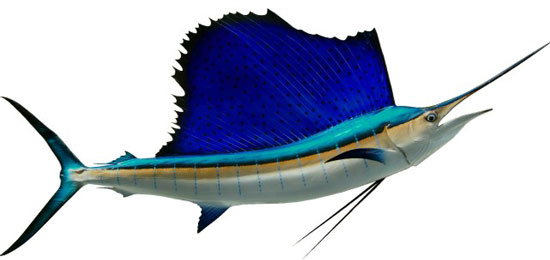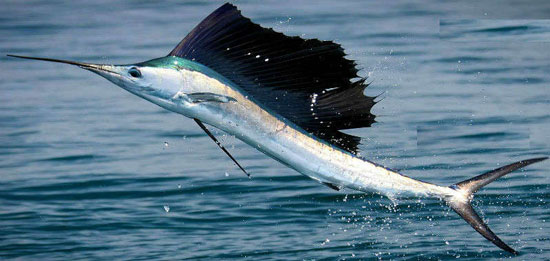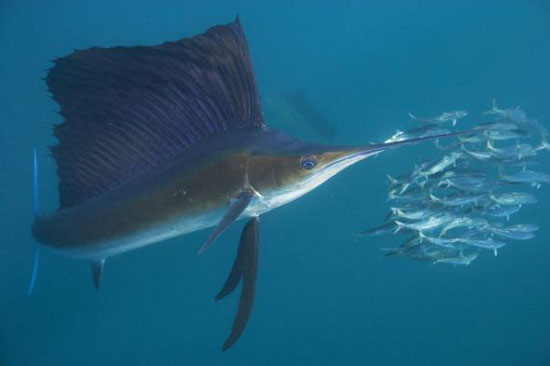|
Have you read my novel Profusion? In my last bi-weekly email, I featured the no-see-um, a tiny insect that Bobby uses to try to stop a planet-threatening outbreak of terrifying creatures. Well, Bobby's plan also involves an aquatic animal, the sailfish. He chooses the sailfish because he knows it is one of the fastest swimming fish. So the sailfish is today's awesome animal. But what the heck is a sailfish. Sailfish are members of the billfish family (Istiophoridae), which also includes marlins. There are two subspecies (or separate species, depending on the source), the Atlantic Sailfish and the Indo-Pacific Sailfish. The sailfish's most striking features are the long, sharp bill (actually the upper jaw) and the tall, flat dorsal fin that stretches most of the length of the body. This dorsal fin is how the fish got its name, sailfish. Amazing facts about Sailfish Sailfish are fast! These are probably the fastest swimming fish on the planet, and many sources say they have been reliably clocked at about 68 miles per hour (110 kilometers per hour). However, some sources say more recent studies indicate they may only swim half that speed. Regardless, that's pretty darn fast when you consider they are moving through a dense liquid (water). Sailfish grow up to eleven feet long and weigh as much as 220 pounds. And they grow very fast, often reaching 4-5 feet in their first year. They are highly valued as game fish. But since their meat is tough and undesirable, they are almost always released alive after being caught. In fact, many places give out release certificates to fisherman who catch and release them. It is thought that the main purpose of the huge sail-like dorsal fin is to help "herd" schools of fish (or squid) during the sailfish's elaborate feeding strategy. Normally, these fins are held flat againt the fish's back and are hardly visible. Amazingly, sailfish cooperate with each other (sometimes dozens or even a hundred or more) to feed on schools of smaller "baitfish." They repeatedly swim around the school of baitfish, using their large fin to herd them into a tight ball, and then the sailfish take turns rushing into the ball of baitfish to slash at them with their long bills. This kills or stuns some of the baitfish and then the sailfish swallow them. This goes on and on until they get their fill. Check out this video of their feeding behavior. When they get excited or stressed, their skin flashes different iridescent colors. In fact, it is thought that they use these color flashes as they feed in cooperative groups. With numerous sailfish darting into the midst of a tight ball of baitfish to feed, it is possible another sailfish could get injured or killed by the attacker's sharp bill. But since they get excited just before dashing into the ball of fish, their skin changes color, warning the other sailfish to get out of the way. Sailfish are very widely distributed, and they are not currently endangered or threatened. The map below shows their overall range (although they are certainly more abundant in some of those areas). When spawning, a large female sailfish will release up to 4,500,000 eggs. Yeesh! Several males will follow her around as she spawns, releasing sperm into the water to fertilize the eggs. Check out this baby sailfish: So, the Sailfish deserves a place in the J.A.H.O.F. (Jake Animal Hall of Fame). FUN FACT: Jake is thought to have originated in North America in the early 1900s. It basically means satisfactory, as in "everything was jake again." It is also used in Australia, with variations such as jakealoo and jakerloo. So, in other words, jake is another way to say awesome. Photo Credits:
Sailfish mount - King Sailfish Mounts Sailfishing Jumping - Cape Verde Islands Sailfish with school of baitfish - Paul Nicklen, National Geographic Creative Sailfish Distribution Map - Florida Museum Baby Sailfish - Bob Cowen
0 Comments
Leave a Reply. |
Stan's Cogitations
Everyone needs a creative outlet. That's why I write. Archives
July 2024
|






 RSS Feed
RSS Feed